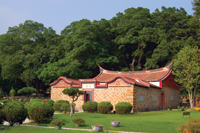
WITH a heavily export-oriented economy, Taiwan has traditionally attracted business travellers who visited the island republic for business and trade. However, with the realisation of leisure tourism’s money-spinning potential – tourism generated revenue of some $11 billion in 2011 for Taiwan – the island republic is now aggressively courting leisure travellers from around the world.
Having coined the slogan “Taiwan – the Heart of Asia” few years back, the Taiwan Tourism Bureau (TTB) is now tapping international markets and set up a pavilion at the International Tourism Bourse 2013 in Berlin, aggressively courting leisure tourists by playing up its tourist attractions, including culture, nature and other assets.
Cheng Ying-Huei, TTB’s deputy director for international promotion, says tourism is one of the top six segments of the economy, contributing some three per cent of the island’s gross domestic product (GD P).
“If in the past, visitors comprised, largely, of business travellers, we now see a growing number of leisure travellers visiting Taiwan. We received some 7.31 million tourists last year, up 20.11 per cent over 2011,” Cheng said in an interview with TTN.
While Western tourists were attracted by nature and culture, tourists of Chinese origin, including many living in Western countries, were drawn by the Sun Moon Lake, the common Chinese culture, Buddhist landmarks and, particularly, traditional Chinese medicine.
“Tourists of Chinese origin also visit Taiwan for shopping and wedding photo-shoots which has become highly popular among young people,” she said.
She spoke of the great interest amongst Western tourists to visit Taiwan. “More and more American tourists are visiting Taiwan … they are interested in eco-tourism, hiking, etc,” she said.
There was also considerable interest among Japanese tourists which, because of historical reasons, find the island republic a fascinating destination. While Japanese usually travel on their own, the mainland Chinese visit in groups.
“But we also see good potential in the Indian market, particularly newly married couples who find Taiwan a good honeymoon destination,” Cheng said, adding that Taiwan is also keen to lure Bollywood producers to shoot films on the island which offers incredibly fascinating background locations that would “enhance the song-and-dance aspects of these films”.
The meetings, incentives, conferences and exhibitions (Mice) segment has also evolved into a lucrative source of tourism.
Despite being part of the overall tourism industry, the Mice segment is handled by Taiwan’s Bureau of Foreign Trade which courts foreign companies to send their employees to Taiwan on incentive travel.
The island’s tourism strategists are also trying to lure tourists by highlighting the country’s natural attractions such as the towering mountains, with peaks rising over 3,000 m, including the Yushan Mountain, considered Northeast Asia’s tallest mountain at 4,000 m high.
Nature tourism, comprising of idyllic coastal beauty, is a major attraction for Westerners who are fascinated by the local tribes that inhabit many villages along the region, and Cheng pointed out that Taiwan has eight national parks.
Taiwan is also keen to develop its cruise tourism. Representatives of the Royal Caribbean International (RCI) were recently in Taiwan to explore business opportunities and RCI representatives said they were impressed by the tourist attractions surrounding Taiwan’s seaports, particularly the Jibel Islet, Aimen Beach, the historical site in Erkan, Penghu County and the old street in Anping in Greater Tainan.
By Manik Mehta
